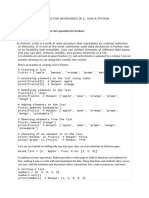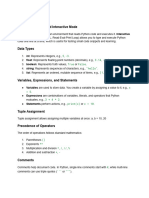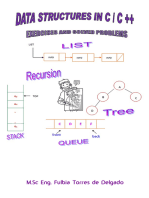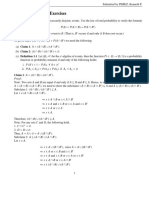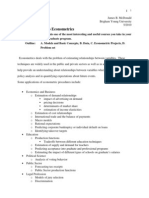Day 2 Python Data Structure and Functions
Uploaded by
Deep gaichorDay 2 Python Data Structure and Functions
Uploaded by
Deep gaichorDay 2: Python Data Structures and Functions
Lists, Tuples, Dictionaries, Sets: Python provides several built-in data structures for
organizing and storing data:
Lists: Ordered collection of items. Mutable, meaning they can be modified after
creation.
Tuples: Similar to lists but immutable, meaning they cannot be modified after
creation.
Dictionaries: Collection of key-value pairs. Keys are unique and immutable, values
can be of any data type.
Sets: Unordered collection of unique items. Useful for mathematical operations like
union, intersection, etc.
List Comprehensions: List comprehensions provide a concise way to create lists. They
consist of an expression followed by a for clause, then zero or more for or if clauses.
# Example of list comprehension
numbers = [1, 2, 3, 4, 5]
squared_numbers = [num ** 2 for num in numbers]
print(squared_numbers) # Output: [1, 4, 9, 16, 25]
Functions: Functions are blocks of reusable code that perform a specific task. They improve
code modularity and reusability.
# Example of defining and calling a function
def greet(name):
return "Hello, " + name + "!"
print(greet("Alice")) # Output: Hello, Alice!
Lambda Functions: Lambda functions, also known as anonymous functions, are small,
single-expression functions without a name.
# Example of a lambda function
add = lambda x, y: x + y
print(add(3, 4)) # Output: 7
Basic Input/Output Operations: Python provides built-in functions for taking input from
the user and displaying output.
# Example of input/output operations
name = input("Enter your name: ")
print("Hello, " + name + "!")
Output:
Enter your name: Bob
Hello, Bob!
These are some of the foundational concepts of Python programming that you'll use
extensively in your journey as a Python programmer.
Day 2: Python Data Structures and Functions
Lists, Tuples, Dictionaries, Sets
Lists:
Ordered, mutable, allows duplicate elements
Created using square brackets []
Example:
fruits = ["apple", "banana", "cherry"]
Common methods:
o append(): Adds an element at the end
o remove(): Removes the first occurrence of an element
o pop(): Removes an element at a given index
Tuples:
Ordered, immutable, allows duplicate elements
Created using parentheses ()
Example:
fruits = ("apple", "banana", "cherry")
Accessed via index: fruits[0]
Dictionaries:
Key-value pairs, unordered, mutable
Created using curly braces {} with colons :
Example:
student = {"name": "Alice", "age": 25, "courses": ["Math",
"Science"]}
Common methods:
o keys(): Returns a view object of all keys
o values(): Returns a view object of all values
o items(): Returns a view object of all key-value pairs
Sets:
Unordered, mutable, no duplicate elements
Created using curly braces {} or the set() function
Example:
fruits = {"apple", "banana", "cherry"}
Common methods:
o add(): Adds an element
o remove(): Removes an element
o union(): Returns a set containing all elements from both sets
List Comprehensions
Concise way to create lists
Syntax: [expression for item in iterable if condition]
Example:
squares = [x**2 for x in range(10)]
even_squares = [x**2 for x in range(10) if x % 2 == 0]
Functions: Defining and Calling Functions, Lambda
Functions
Defining and Calling Functions:
Use the def keyword
Example:
def greet(name):
return f"Hello, {name}!"
print(greet("Alice"))
Lambda Functions:
Anonymous functions defined with the lambda keyword
Syntax: lambda arguments: expression
Example:
add = lambda x, y: x + y
print(add(2, 3))
Basic Input/Output Operations
Input:
Using input() to get user input
Example:
name = input("Enter your name: ")
print(f"Hello, {name}!")
This concludes the note for Day 2: Python Data Structures and Functions.
You might also like
- Instant Download Maths in focus mathematics extension 1 Year 12 Margaret Grove PDF All Chapters100% (3)Instant Download Maths in focus mathematics extension 1 Year 12 Margaret Grove PDF All Chapters65 pages
- Ch05 - Python - Data Structures - 1721754633No ratings yetCh05 - Python - Data Structures - 172175463337 pages
- Sequence_mapping_branching self made notesNo ratings yetSequence_mapping_branching self made notes9 pages
- Data Structures - Python 3.9.6 DocumentationNo ratings yetData Structures - Python 3.9.6 Documentation15 pages
- Mooc Seminar: Name Rajat Kushwaha St. Id 200211241 Section I'No ratings yetMooc Seminar: Name Rajat Kushwaha St. Id 200211241 Section I'46 pages
- Python_Programming_Exam_Solutions_with_Section_CNo ratings yetPython_Programming_Exam_Solutions_with_Section_C6 pages
- Columbiax - BAMM 101 - Python For AnalyticsNo ratings yetColumbiax - BAMM 101 - Python For Analytics38 pages
- Imp Question - Python Questions by Hari For PlacementNo ratings yetImp Question - Python Questions by Hari For Placement12 pages
- unit-2 - More data types- List, tuples, set, dictNo ratings yetunit-2 - More data types- List, tuples, set, dict24 pages
- AIML%20Short%20Term%20Internship%20Session%2013%20Summary-1719637291003No ratings yetAIML%20Short%20Term%20Internship%20Session%2013%20Summary-17196372910037 pages
- Artificial Neural Network: Training: Debasis SamantaNo ratings yetArtificial Neural Network: Training: Debasis Samanta13 pages
- The Forecasting of Durian Production Quantity For Consumption in Domestic and International MarketsNo ratings yetThe Forecasting of Durian Production Quantity For Consumption in Domestic and International Markets12 pages
- Boosting The RSI With Modified Inverse Fisher Transform MIFT Part 1No ratings yetBoosting The RSI With Modified Inverse Fisher Transform MIFT Part 17 pages
- Minggu 5 - Spatial Interaction Modelling PDFNo ratings yetMinggu 5 - Spatial Interaction Modelling PDF29 pages
- ACM International Collegiate Programming Contest 2010: Latin American Regional ContestsNo ratings yetACM International Collegiate Programming Contest 2010: Latin American Regional Contests4 pages
- 2122 F1 Maths Midyr Section B Marking Ss VerNo ratings yet2122 F1 Maths Midyr Section B Marking Ss Ver10 pages
- Mathematics_Grade_4_Controlled_Test_Term_2_2023[1]No ratings yetMathematics_Grade_4_Controlled_Test_Term_2_2023[1]6 pages
- Multi Variable Calculus: Dr. G.V.S.R. DeekshituluNo ratings yetMulti Variable Calculus: Dr. G.V.S.R. Deekshitulu76 pages




































